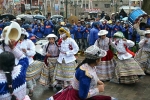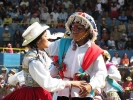Print
IDENTIFICATION | IDENTIFICACIÓN | IDENTIFICAÇÃO
Tangible or Intangible
Intantigle | Inmaterial | Imaterial
Image credits | Créditos de imagen | Créditos de imagem
© Ministerio de Cultura del Perú, 2014
Title, name | Titulo, nombre | Título, nome
La danza del wititi del valle del Colca
Short description | Descripción corta | Descrição resumida
La danza del wititi del valle del Colca es un baile popular tradicional que guarda relación con el comienzo de la edad adulta. Reviste la forma de un ritual de cortejo amoroso y suelen interpretarla los jóvenes durante las festividades religiosas que se celebran a lo largo de la estación lluviosa. Las parejas de bailarines y bailarinas se alinean en filas y ejecutan diversos pasos al compás de la música. Las bailarinas llevan trajes finamente bordados con motivos naturales de colorido vistoso y van tocadas con sombreros característicos. Por su parte, los bailarines llevan dos faldas de mujer superpuestas, una camisa militar, un chal y sombreros con aditamentos. La representación del wititi coincide con el inicio del ciclo de producción agrícola y simboliza el renuevo de la naturaleza y la sociedad. Esta danza consolida los vínculos sociales y la identidad de los pueblos del valle del Colca, que compiten para presentar los mejores conjuntos de danza, renovándola así continuamente y perpetuando al mismo tiempo su carácter tradicional.
The Wititi dance of the Colca Valley is a traditional folk dance associated with the beginning of adult life. It takes the form of a courtship ritual and is typically performed by young people during religious festivities celebrated throughout the rainy season. It is danced in troupes with rows of male and female couples performing a variety of steps to the beat of a band. Female dancers wear garments finely embroidered with colourful natural motifs and distinctive hats, while male dancers wear overlapping women’s skirts, military shirts, slings and ‘strong hats’. The dance coincides with the beginning of the agricultural production cycle and symbolizes the renewal of nature and society. The dance consolidates social ties and strengthens cultural identity with villages in the Colca Valley competing to produce the best ensembles, thereby continuously renewing the dance while maintaining its traditional character.
The Wititi dance of the Colca Valley is a traditional folk dance associated with the beginning of adult life. It takes the form of a courtship ritual and is typically performed by young people during religious festivities celebrated throughout the rainy season. It is danced in troupes with rows of male and female couples performing a variety of steps to the beat of a band. Female dancers wear garments finely embroidered with colourful natural motifs and distinctive hats, while male dancers wear overlapping women’s skirts, military shirts, slings and ‘strong hats’. The dance coincides with the beginning of the agricultural production cycle and symbolizes the renewal of nature and society. The dance consolidates social ties and strengthens cultural identity with villages in the Colca Valley competing to produce the best ensembles, thereby continuously renewing the dance while maintaining its traditional character.
Community or culture | Comunidad o cultura | Comunidade ou cultura
Comunidad del valle del Colca
Practitioners, Autor | Practicantes, Autores | Praticantes, Autores
Museum | Museo | Museu
Place | Local | Local
Colca Valley
Country | País
Peru
Language | Idioma
spanish
MEDIA
Video | Vídeo
Video credits | Créditos de vídeo | Créditos vídeo
© Ministerio de Cultura del Perú, 2014
Audio
Audio Credits | Créditos de Audio
3D object | Objeto 3D
3D Credits | Créditos 3D
Text | Texto
Text credits | Créditos del texto | Créditos do texto
Record date | Fecha de registro | Data do registo
Image 1 credits | Créditos imagen 1 | Créditos da imagem 1
Ministry of Culture, 2014in Unesco ICH website
Image 2 credits | Créditos imagen 2 | Créditos da imagem 2
Ministry of Culture, 2014in Unesco ICH website
Image 3 credits | | Créditos da imagem 3Créditos imagen 3
Ministry of Culture, 2014in Unesco ICH website
Image 4 credits | Créditos imagen 4 | Créditos da imagem 4
Ministry of Culture, 2014in Unesco ICH website
MORE INFORMATION | MÁS INFORMACIÓN | MAIS INFORMAÇÃO
Origin, history | Origen, historia | Origem, história
Associated heritage | Patrimonio asociado | Património associado
Cross reference | Referencias cruzadas | Referências cruzadas
Present condition | Condición actual | Estado actual
Threats | Amenazas | Ameaças
Safeguard | Salguardia | Salvaguarda
Bibliography | Bibliografía | Bibliografia
Source | Fuente | Fonte
TANGIBLE | MATERIAL
Type of object | Tipo de objeto | Tipo de objecto
Domain | Dominio | Domínio
Please select
Category | Categorías | Categoria
Please select | Seleccionar
Materials & techniques | Materiales y técnicas | Materiais & Tecnicas
Measurements | Medidas
Aditional info | Información adicional | Informação adicional
INTANGIBLE | INMATERIAL | IMATERIAL
Domain | Dominio | Dominío
Social practices rituals and festive events | Prácticas sociales y eventos festivos | Práticas sociais e celebrações
Category | Categoria
Cyclical festivities | Fiestas cíclicas | Festividades cíclicas, Rites of passage | Ritos de paso | Ritos de passagem
Periodicity | Periodicidad | Periodicidade
Annually
Transmission | Trasmisión | Transmissão
The Wititi dance of the Colca Valley is learned through direct observation by youth and children in school and at private family gatherings, such as christenings, birthdays and weddings. At the national level, folk dance ensembles perform this dance as part of their repertoires.







